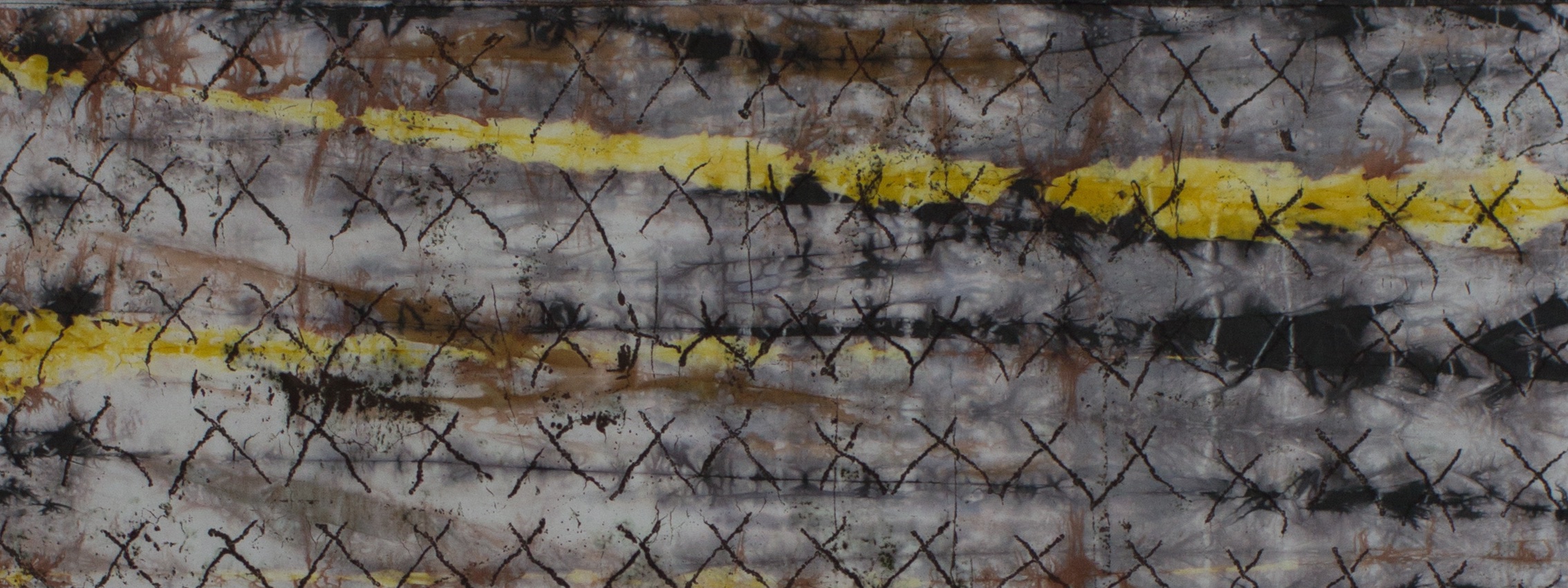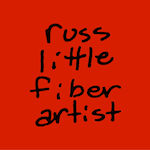
Thoughts & news
Human Marks : Day 5 (final thoughts)
[Edited 5/28, 10:00 PM to correct typos]
I took this photo on a walk after lunch Thursday for both inspiration and memory. It might sound a little precious, but I keep thinking "Rows of corn; rows of stitching." In some way that I don't yet fully understand, that seems to encapsulate this week. One of the things that's really staying with me is the stitching--on fabric, on paper, alone, and in small circles of new friends. Stitch is transformative. It joins fabric into garments to cover and protect out bodies; it decorates functional items; it's a tool for artists. And yet stitch, like weaving, has become mechanized to the point that we hardly give a thought to its presence in our lives.
I have sewing machines that can make 1,500 stitches per minute, and others that sew with 3 or 4 needles at a time. I treasure and rely on these tools to do my work, and I'd hate to be without them. Gosh, I wonder if I even managed to sew 1,500 stitches by hand this week! Not too many generations ago (and still today in some places) hand stitch and hand weaving were more the norm than the exception. Textile, thread, and needles were treasured. Garments were cared for and mended. As a consequence of industrial sewing and weaving, garments have become disposable. We replace rather than mend, and more often than not, we replace out of a desire for the new and chic.
More troubling than our cultural perception of garment and textile as disposable, is our expectation of an unending supply of product at an affordable price. Machine or no machine, someone is making the clothes you wear, even those purchased at a discount store for less than you might spend for lunch. Add to this thought the notion that hand stitched embellishments are time consuming and done entirely by people, not machines.
I feel as though I'm rambling and grasping to draw these thoughts together. It's basically this: Somebody made my clothes, linens, etc. Even if I made some of the clothing, I didn't weave the fabric. Think of all the people involved in the production of a single garment and all of the folks taking their share of the profit. How much money makes it back to the person with his or her hands in the soil or on the sewing machine, or stitching away by hand?
I don't know what to do with that question except to be with it in the hope that greater mindfulness and better stewardship will follow.
It's been wonderful to spend another week at the Barn, to reconnect with a few old friends, and make new connections. Stated simply, Dorothy Caldwell is not only a gifted artist, but a generous teacher. She has a talent for gently moving around the room, connecting with each of her students, and offering suggestions and words of encouragement that seem to keep each person on track--whatever that individual's track might be. Along the way she also interjects thought-provoking ideas, like our discussion and practice of hand stitching, which led to the thoughts above. If you're a visual artist of any sort then I say you can't go wrong with one of Dorothy's classes.
Human Marks : Day 4
Today was all about bookbinding. Well, sort of. The task of binding our books superficially involved the mechanics of a simple stitched binding. On a deeper level it was an exercise in recognizing and solving a whole series of design problems. The pages that we've created this week all have a fold down the middle like a greeting card. Folded in half they form 4 pages. Assembling a book with some sort of flow involves sorting, selecting--and in come cases modifying--these groups of pages so that they work together, even though we didn't really plan how this was going to work from the outset. It was a great exercise. The photo above shows the end-of-day status for all of my projects for the week. Some things are not totally finished, but finished enough for the group review tomorrow morning.
The photos below show the binding for one of the books coming together. This was seriously fun and I think I might be doing more on my own.
Book signatures (groups of folded pages) assembled and ready for binding.
All of the signatures individually stitched with waxed linen thread and held together temporarily with a rubber band.
The final bound book. The signatures are all connected together by weaving embroidery floss through the waxed linen threads along the spine edge of each signature. That crazy nest of waxed thread hanging off the spine of the book is staying as a design element (it's art).
Human Marks : Day 2 + 3
Indian Kantha sample from Dorothy's collection.
Sorry for not posting yesterday. It was a LONG day. I got back to the hotel around 9 and continued stitching until about 1030. Yesterday started with a fantastic slide talk about kantha stitching in India (https://en.wikipedia.org/wiki/Kantha) and the work that Dorothy and some of her colleagues have done to document and support the work of local women. As I said in the Day 1 post, we're collecting our work into a hand bound volume. Yesterday we spent the better part of the day stitching a kantha-style cover for the book. How hard or time consuming could that possibly be? The answer is rather. Most of us aren't hand stitchers, so there's a bit of re-learning and slow going, but we're all making great progress between yesterday and today. The underlying lesson is that the oh-so-affordable hand stitched souvenir from your vacation or that catalog item from India or elsewhere was made by someone who labored for days to create it. Think about that and then look again at the price. It's sobering.
This is were I started: blank cloth and simple tools.
By about mid-day today I was here.
Betwixt and between bouts of stitching there've been more slide talks, more mark-making exercises (including taking a hammer and nail to paper!), great food, and wonderful conversation and camaraderie. We've got a really great group of super-talented folks in class and there's great energy flowing.
Human Marks : Day 1
I'm here in Ohio at the Crow Timber Frame Barn (nancycrow.com) for a one week workshop with Dorothy Caldwell (dorothycaldwell.com) titled, "Human Marks". I've admired the mark quality in Dorothy's work for many years, and countless friends and colleagues have recommended her workshops. I'm thrilled to finally have an opportunity to study with her.
As the name says, this workshop is all about human marks made in a variety of ways--fingerprints, pen, paint, burning, stitching, etc. The tangible end product will be several small hand bound books containing the results of our mark-making exercises. The intangible "product" is that there really isn't a product per se. We're making these marks without purpose, and the books will be a collection with no purpose other than to be an artifact of the time. The marks aren't intended to be representational or patternistic. They just are.
It's a rare thing for me to spend five days doing something that isn't driving toward a goal. I'm enjoying it. Here are a few samples of today's work.
Marks make with a pen (mine's the one in the center).
Marks make with a brush and india ink. The tall piece to the right make with fingerprints. The small bits on the far right are marks burned into cloth with incense.











